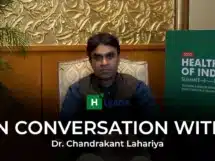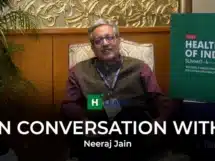Dr Suvanand Sahu is the Deputy Executive Director of the Stop TB Partnership, a global partnership committed to eliminating Tuberculosis as a public health problem by 2030.
In an interview with Shruthi Manjula Mohan, Dr Sahu discussed the work of the Stop TB Partnership and its support to TB-affected communities, governments, health and human rights organizations, and the public. This includes awareness-raising campaigns, social mobilization, educational programs, and more.
“At Stop TB, we advocate a people-centered approach and not a health system or health service, or health facility approach,” Dr Sahu said. “It’s people who are suffering from TB, so the health services have to follow the people.”
Excerpts from the interview:
Given that you have spent nearly ten years of your life working in this field, how has the battle against tuberculosis unfolded through your eyes?
Tuberculosis is an infectious disease as you know. Over the last several decades, it has killed more people than any other infectious disease. Only in 2020-2021, COVID killed more people than TB. According to WHO Publications, TB killed 1.6 million people in 2021. Though this is a disease that can be diagnosed, treated, and prevented, so many people are dying due to TB and this is the challenge that the Stop TB Partnership is working to address.
Globally about 10 million people develop TB each year, they fall sick and they need diagnosis, treatment, and care. India is the number one high-burden country.
Tuberculosis is often looked at as a poor man’s disease?
TB is there all over the world. Many countries report TB cases each year to WHO, so it exists everywhere. The so-called richer countries – North American countries, Western European countries, Australia, and Japan – have brought down the rates of TB. They also had very high rates of TB, several decades ago. So now if you look at the concentration of TB it is more in the developing world, especially in East Asia, Africa and in Eastern Europe, Central Asian countries where the rates of TB are not higher but they have a problem of drug-resistant TB.
Do you face taboos and stereotypes on the ground as Tuberculosis continues to be perceived as a “poor man’s disease.”
TB can affect everybody, as it’s an airborne disease. As long as we breathe in air, we are all exposed. COVID too behaved the same way, as we saw in the last few years. Yet, those who die due to TB, are from economically weaker sections while COVID affected even rich countries. But, TB is still a disease, which is associated with poverty, overcrowding, and poor living conditions. It disproportionately impacts poor people in poorer countries.
If you take a map of where poverty exists in the world and overlay it with a map of where TB exists, it aligns very well. So it indeed is a disease of poverty. It also is a socio-economic issue not just a health issue.
Enough studies are highlighting the social impact of TB, particularly in India. Some studies show how stigma affects society here. For example; young girls cannot get married and they suppress the information about TB. Families are disrupted because of TB, and people lose income because of the disease. Patients who work for the unorganized sector face the consequences of not just the medical symptoms of the disease, but they encounter a huge social and economic burden. TB affects all age groups, particularly people who are economically productive, leading to a loss of workdays in the economy.
What makes targeting the poor and vulnerable so important in TB eradication campaigns?
The challenge we have is that there are not enough investments, because of which the tools we have for prevention, diagnosis, and treatment are not reaching everybody. Out of the 10 million people that develop TB each year globally, three to four million are not able to access care.
At Stop TB, we advocate for a people-centered approach and not a health system or health service, or health facility approach. It’s people who are suffering from TB, so the health services have to follow the people. What is needed is a decentralized care system and I think the COVID-19 pandemic taught us great lessons that people don’t have to come to a health center to access basic care, it was provided to them at a primary health care center, sometimes even at their homes.
Countries should move towards decentralized care for TB. Health systems that are driven by any community should be empowered. We must invest in them and make them fit to deliver care. Also, enabling this community with digital tools will dramatically increase access. The COVID-19 pandemic has helped us leapfrog healthcare delivery systems.
In countries like Africa, X-ray services are only accessible in premium hospitals. Sometimes, these reports take a week, because radiologists are in short supply across the world. But, with technology now, you don’t need a radiologist to give you the report, the artificial intelligence software reads the X-ray and gives you a report in seconds. The X-ray machines have miniaturized in size, there are hand-held ones now, and some are carried in a mobile van. As of date, AI is outperforming trained radiologists.
Can Ayurveda cure TB? Or for that matter any other non-allopatic Indian system of medicine?
TB is an infectious disease. Treatment for TB treatment is not like any other antibiotic treatment that you take for five days and you are done. It takes several months. So the treatment of killing the bug in the body can happen only through modern medicine.
Since Tuberculosis is also an air-borne disease like the Coronavirus, is there any similarity beyond that?
TB is transmitted through droplets of air, so it is an air-borne disease and we have all seen what such diseases can do. A certain proportion of TB is drug-resistant which means that they cannot be treated with regular drugs, but you have to use, what we call- second-line drugs which are more expensive and have more side effects. They usually follow a longer and more difficult path to cure and this diagnosis requires some specialized arrangements.
At the Stop TB partnership, we are advocating that this disease, which has a prevention, diagnosis, treatment, and technology can be ended.
Countries that follow the sustainable development goals have a target that by 2030, they will be able to address the cause and work towards TB eradication. India is the number one high-burden country, but India also has the highest level of political commitment to address TB. India put out a vision that it wants to achieve its sustainable development target of ending TB, not by 2030, but by 2025.
What is the importance of partnerships in a dynamic space such as healthcare?
Partnerships at different levels, whether it’s at the community or the government level are imperative in tackling the disease. However, studies have shown that even the working poor, staying in slums prefer to go to a private provider. In India, some initiatives and models are more advanced than in many other countries where the private sector is involved. It has the same quality of care and is easily accessible. Secondly, the private sectors are important for Innovations and product development. TB was first diagnosed under a microscope.
Was the COVID-19 pandemic, a boon or a bane for TB?
COVID was a great learning experience. It did two things to TB programs: one, it setback the effort for two years. But most countries have performed better in many health indexes after this phase. When we look back at our data, access to treatment was the highest ever.
Two, all the digital tools leapfrogged and the care delivery model has decentralized the focus on rapid molecular testing genetic sequencing. All these factors have benefitted TB including the focus on contact investigation. So anything that was done at scale for COVID will benefit TB in the future. If you have to address future pandemics, you have to put TB at the center, as an airborne disease.
Also Read: ‘Tuberculosis has been known to mankind since 20,000 years ago’


















Add Comment